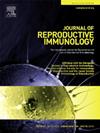子痫前期线粒体遗传景观及其与免疫细胞浸润的相关性:来自生物信息学的见解
IF 2.9
3区 医学
Q3 IMMUNOLOGY
引用次数: 0
摘要
背景子痫前期(PE)是一种妊娠高血压疾病,是孕产妇和围产期发病和死亡的主要原因。线粒体相关的胎盘代谢功能障碍与PE有关,但其机制作用尚不清楚。本研究旨在鉴定线粒体相关基因(MRGs)及其在PE中的可能调控机制。方法从Gene Expression Omnibus (GEO)数据集GSE114691和GSE190971中鉴定PE差异表达的线粒体相关基因(MRGs)。LASSO回归分析筛选关键mrg。数据集GSE75010和GSE25906通过受试者工作特征(ROC)曲线分析验证MRGs预测模型的有效性。基因集富集分析(GSEA)用于验证PE潜在的生物学途径。此外,我们还研究了MRGs与免疫细胞浸润的相关性分析,以及MRGs与临床特征的相关性。单细胞测序和免疫荧光染色验证了胎盘中关键基因的表达。结果MOCS1、CYP11A1、GATM、SFXN3、BCL2L11 5个中心MRGs对PE的诊断准确率较高,且与免疫细胞浸润相关。CYP11A1进一步与溶血、肝酶升高、低血小板(HELLP)综合征相关,主要表达于上皮外滋养细胞,在PE胎盘中表达上调。结论核磁共振成像与免疫微环境的相互作用可能在PE的发生发展中起重要作用。在5个中心MRGs中,CYP11A1可能是HELLP综合征的潜在生物标志物。这些发现为PE的潜在病理生理学和新的治疗靶点的发现提供了新的见解。本文章由计算机程序翻译,如有差异,请以英文原文为准。
Mitochondrial genetic landscape and its correlation with immune cell infiltration in preeclampsia: Insights from bioinformatics
Background
Preeclampsia (PE), a hypertensive pregnancy disorder, remains a leading cause of maternal and perinatal morbidity and mortality. Mitochondria-related placental metabolic dysfunction is implicated in PE, but its mechanistic role is unclear. This study aimed to identify mitochondria-related genes (MRGs) and their possible regulatory mechanisms in PE.
Methods
Differentially expressed mitochondria-related genes (MRGs) of PE were identified from Gene Expression Omnibus (GEO) dataset GSE114691 and GSE190971. LASSO regression analysis was used to screen key MRGs. Datasets GSE75010 and GSE25906 were used to validate the efficiency of the MRGs predictive model via receiver operating characteristic (ROC) curve analysis. Gene set enrichment analysis (GSEA) was conducted to verify underlying biological pathways in PE. Furthermore, we investigated the correlation analysis of MRGs and immune cell infiltration, as well as the association between the MRGs and clinical features. Single-cell sequencing analysis and immunofluorescence staining were used to verify the expression of critical gene in the placenta.
Results
Five hub MRGs (MOCS1, CYP11A1, GATM, SFXN3, and BCL2L11) showed high diagnostic accuracy for PE and correlated with immune cell infiltration. CYP11A1 was further associated with Hemolysis, Elevated Liver enzymes, Low platelets (HELLP) syndrome and predominantly expressed in extravillous trophoblasts, with upregulated expression in PE placenta.
Conclusion
The interaction between MRGs with the immune microenvironment might be vital in the development of PE. Among 5 hub MRGs, CYP11A1 might be a potential biomarker of HELLP syndrome. These findings provide novel insights into the underlying pathophysiology of PE and the discovery of new therapeutic targets.
求助全文
通过发布文献求助,成功后即可免费获取论文全文。
去求助
来源期刊
CiteScore
6.30
自引率
5.90%
发文量
162
审稿时长
10.6 weeks
期刊介绍:
Affiliated with the European Society of Reproductive Immunology and with the International Society for Immunology of Reproduction
The aim of the Journal of Reproductive Immunology is to provide the critical forum for the dissemination of results from high quality research in all aspects of experimental, animal and clinical reproductive immunobiology.
This encompasses normal and pathological processes of:
* Male and Female Reproductive Tracts
* Gametogenesis and Embryogenesis
* Implantation and Placental Development
* Gestation and Parturition
* Mammary Gland and Lactation.

 求助内容:
求助内容: 应助结果提醒方式:
应助结果提醒方式:


